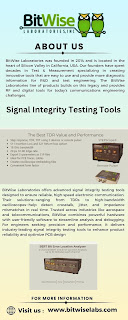How to Measure Return Loss – A Technical Guide by BitWise Laboratories
Understanding how to measure return loss is essential for
evaluating the performance of cables, connectors, and communication systems.
Return loss indicates how much signal is reflected back due to impedance
mismatches in the transmission line. A higher return loss value represents
better signal quality and lower reflection, ensuring efficient data transfer. BitWise Laboratories specializes in
advanced signal integrity testing and provides accurate solutions for measuring
return loss in various network applications.
To measure return loss effectively, the process begins with
connecting a Vector Network Analyzer (VNA) or Time Domain Reflectometer (TDR)
to the device under test. The analyzer sends a known signal through the cable
or connector and measures the reflected signal returning to the source. The
ratio of the reflected signal to the incident signal is then expressed in
decibels (dB). At BitWise Laboratories, engineers use state-of-the-art
equipment to ensure precise readings across different frequencies and environments.
Proper calibration is a crucial step in how to measure return loss accurately.
This involves minimizing external factors such as connector wear, environmental
noise, or improper terminations that can affect results. A well-calibrated
setup ensures consistent, repeatable measurements that meet industry standards.
At BitWise Laboratories, the focus extends beyond
measurement — it’s about interpretation and optimization. Engineers analyze
return loss data to identify potential mismatches or manufacturing defects,
helping clients improve product reliability and performance. Their expertise
supports industries including telecommunications, defense, and electronics
manufacturing.
In conclusion, knowing how to measure return loss helps
maintain signal integrity and optimize system design. With advanced tools,
expert analysis, and precision testing, BitWise Laboratories ensures that every
component performs flawlessly — delivering the clarity, accuracy, and
reliability your systems deserve.




Comments
Post a Comment